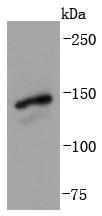Product Detail
Product NameGli1 Rabbit mAb
Clone No.JF09-08
Host SpeciesRecombinant Rabbit
Clonality Monoclonal
PurificationProA affinity purified
ApplicationsWB, ICC, IHC
Species ReactivityHu, Ms, Rt
Immunogen Descrecombinant protein
ConjugateUnconjugated
Other NamesGli 1 antibody
GLI antibody
GLI family zinc finger 1 antibody
GLI Kruppel family member 1 antibody
gli1 antibody
GLI1_HUMAN antibody
Glioma associated oncogene 1 antibody
Glioma associated oncogene homolog 1 (zinc finger protein) antibody
Glioma associated oncogene homolog antibody
Glioma-associated oncogene antibody
Oncogene GLI antibody
Zfp 5 antibody
Zfp5 antibody
Zinc finger protein GLI 1 antibody
Zinc finger protein GLI1 antibody
Accession NoSwiss-Prot#:P08151
Uniprot
P08151
Gene ID
2735;
Calculated MW150 kDa
Formulation1*TBS (pH7.4), 1%BSA, 40%Glycerol. Preservative: 0.05% Sodium Azide.
StorageStore at -20˚C
Application Details
WB: 1:500-1:1,000
IHC:1:50-1:200
ICC: 1:50-1:200
Western blot analysis of Gli1 on SH-SY-5Y cells lysates using anti-Gli1 antibody at 1/1,000 dilution.
ICC staining Gli1 in HepG2 cells (red). The nuclear counter stain is DAPI (blue). Cells were fixed in paraformaldehyde, permeabilised with 0.25% Triton X100/PBS.
ICC staining Gli1 in SH-SY-5Y cells (red). The nuclear counter stain is DAPI (blue). Cells were fixed in paraformaldehyde, permeabilised with 0.25% Triton X100/PBS.
ICC staining Gli1 in 293T cells (red). The nuclear counter stain is DAPI (blue). Cells were fixed in paraformaldehyde, permeabilised with 0.25% Triton X100/PBS.
Zinc-finger proteins contain DNA-binding domains and have a wide variety of functions, most of which encompass some form of transcriptional activation or repression. The majority of zinc-finger proteins contain a Krppel-type DNA binding domain and a KRAB domain, which is thought to interact with KAP1, thereby recruiting histone modifying proteins. GLI-1 (GLI family zinc finger 1), also known as Glioma-associated oncogene or oncogene GLI, is a 1,106 amino acid protein that localizes to both the cytoplasm and nucleus, and belongs to the GLI C2H2-type zinc-finger protein family. GLI-1 acts as a transcriptional activator and is thought to play a role in craniofacial development. GLI-1 exists as two alternatively spliced isoforms and is encoded by a gene that maps to human chromosome 12q13.3.
If you have published an article using product 49399, please notify us so that we can cite your literature.






 Yes
Yes



